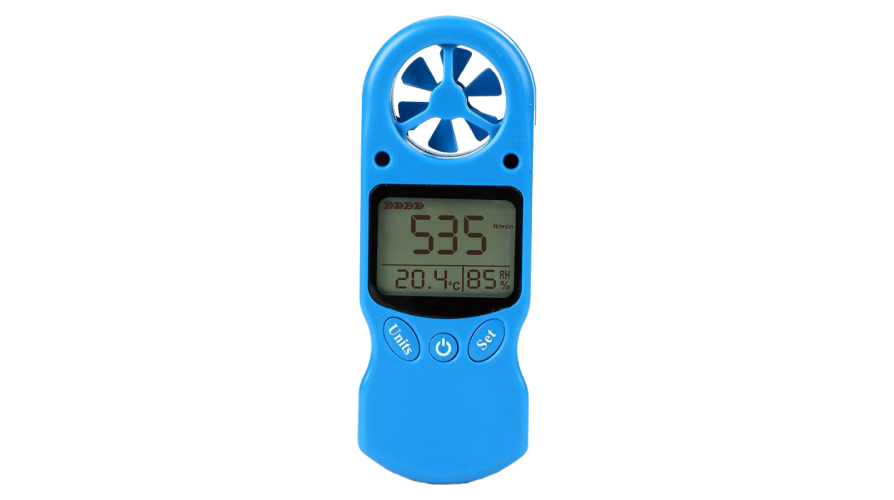Understanding Different Types of Anemometers for Various Applications
Understanding Different Types of Anemometers for Various Applications
Blog Article
Anemometers Revealed: Comprehending Their Value in Ecological Monitoring and Safety Procedures
The function of anemometers in environmental tracking and security measures is often taken too lightly, yet their relevance is undeniable. From meteorology to air travel safety, anemometers play a critical function in providing precise data that informs decision-making procedures and enhances total security.
Background of Anemometers
The development of anemometers can be traced back to the ancient worlds where rudimentary wind gauging gadgets were very first used. One of the earliest known anemometers was the hemispherical cup anemometer developed by Leon Battista Alberti in the 15th century.
Over the years, developments in innovation led to the development of more modern anemometers, consisting of ultrasonic anemometers and laser Doppler anemometers, using increased accuracy and effectiveness in gauging wind speed and instructions. The background of anemometers showcases an amazing journey of advancement and progression in the area of weather forecasting.
Sorts Of Anemometers
Throughout the field of meteorology, numerous kinds of anemometers have been created to properly determine wind rate and instructions. One of the most typical type is the cup anemometer, which is composed of 3 or 4 mugs placed on straight arms that rotate with the wind. As the cups spin, the speed at which they turn is straight symmetrical to the wind speed. One more extensively utilized kind is the vane anemometer, which includes a tail or fin that straightens itself with the wind direction. This positioning permits the device to identify the wind direction. Sonic anemometers utilize ultrasonic signals to measure wind rate and instructions accurately. They are typically utilized in research applications because of their high accuracy. Hot-wire anemometers operate based upon the principle that the cooling result of wind on a warmed cable is symmetrical to the wind rate. These anemometers appropriate for determining low wind rates with high precision. Each kind of anemometer has its toughness and is chosen based upon the particular demands of the tracking task at hand.
Applications in Meteorology
Having discussed the various kinds of anemometers utilized in meteorology for measuring wind speed and instructions, it is necessary to discover their functional applications in the area. Anemometers play a critical duty in meteorology by offering exact and real-time information on wind problems (anemometer). Meteorologists use anemometers to keep track of wind speed and instructions to anticipate weather condition patterns, concern warnings for serious weather occasions like tornados, hurricanes, and hurricanes, and assess weather for aeronautics security
In weather forecasting, anemometers assist in recognizing regional and regional wind patterns, which are essential for forecasting weather modifications and determining weather fads. These tools are also made use of in research study to study microclimates, urban heat islands, and air contamination diffusion. Additionally, anemometers are utilized in agriculture to maximize plant management practices, such as watering and pesticide application, based on wind problems.
Value in Air Travel Security
An important facet of guaranteeing air travel safety hinges on the careful monitoring of wind problems using anemometers. Anemometers play an essential duty in aeronautics by offering real-time data on wind rate and direction, helping pilots in making educated choices during flight, landing, and take-off. Unforeseeable and strong winds can significantly affect airplane operations, Recommended Reading making it vital for aviation authorities to count on exact wind measurements to make certain the safety of guests and staff.

In the dynamic environment of aviation, this where even small changes in wind speed and direction can have extensive results, anemometers stand as essential tools for promoting secure and secure flight.
Duty in Environmental Research Study
Exactly how do anemometers add to developments in environmental research? Anemometers play an essential duty in ecological research study by supplying crucial data on wind speed and instructions. This info is important for understanding various climatic processes, such as air pollution diffusion, weather patterns, and climate modification. By properly gauging wind attributes, anemometers assist researchers evaluate the movement of pollutants in the air, examine the effect of commercial exhausts, and anticipate the spread of contaminants in the setting.


Conclusion
In final thought, anemometers have played an important role in environmental tracking and security measures. Comprehending the significance of anemometers is essential for precisely measuring wind rate and instructions, which is vital for anticipating weather patterns, guaranteeing secure air travel procedures, and conducting environmental research studies.
One of the earliest well-known anemometers was the hemispherical cup anemometer invented by Leon Battista Alberti in the 15th century. Over the years, improvements in modern technology led to the growth of more modern-day anemometers, consisting of ultrasonic anemometers and laser Doppler anemometers, supplying boosted accuracy and efficiency in determining wind speed and direction. Hot-wire anemometers operate based on the principle that the cooling result of wind on a warmed cord is proportional to the wind rate. Meteorologists use anemometers to check wind rate and direction to anticipate weather patterns, concern cautions for serious climate occasions like storms, typhoons, and hurricanes, and evaluate atmospheric problems for aviation safety.
Recognizing the value of anemometers is crucial for precisely determining wind speed and direction, which is important for anticipating weather patterns, ensuring secure her latest blog aviation operations, and carrying out environmental studies. (anemometer)
Report this page